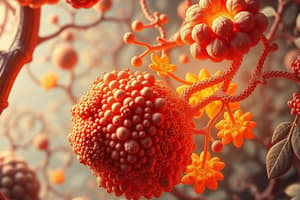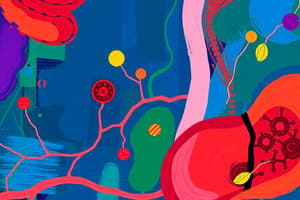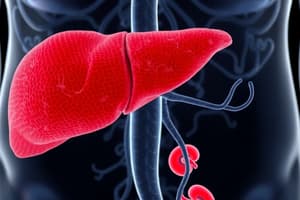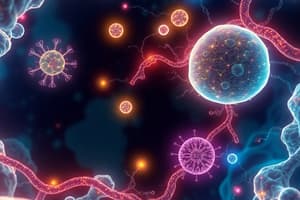Podcast
Questions and Answers
In gluconeogenesis, which of the following substrates can be utilized for glucose synthesis?
In gluconeogenesis, which of the following substrates can be utilized for glucose synthesis?
- Fatty acids
- Ketone bodies
- Acetyl CoA
- Glycerol (correct)
Which statement accurately describes the cellular location of key gluconeogenic enzymes?
Which statement accurately describes the cellular location of key gluconeogenic enzymes?
- All gluconeogenesis enzymes are located in the cytosol.
- Gluconeogenesis enzymes are located in the cytosol, except for glucose-6-phosphatase in the ER and pyruvate carboxylase in the mitochondria. (correct)
- All gluconeogenesis enzymes are located in the endoplasmic reticulum (ER).
- Gluconeogenesis enzymes are located in the mitochondria, except for fructose-1,6-bisphosphatase in the cytosol.
Which regulatory mechanism ensures that glycolysis and gluconeogenesis do not operate simultaneously at high rates, leading to a futile cycle?
Which regulatory mechanism ensures that glycolysis and gluconeogenesis do not operate simultaneously at high rates, leading to a futile cycle?
- Substrate-level control of all enzymes involved in both pathways
- Reciprocal allosteric regulation and transcriptional control of key enzymes (correct)
- Transcriptional control of glycolytic enzyme genes
- Compartmentalization of the pathways in different cellular organelles
If a cell has excess ATP and NADH, and also has high concentrations of lactate and pyruvate, which metabolic pathway is most likely to be activated?
If a cell has excess ATP and NADH, and also has high concentrations of lactate and pyruvate, which metabolic pathway is most likely to be activated?
Which of the following allosteric effectors inhibits fructose-1,6-bisphosphatase, thus regulating gluconeogenesis?
Which of the following allosteric effectors inhibits fructose-1,6-bisphosphatase, thus regulating gluconeogenesis?
What is the role of biotin in the pyruvate carboxylase reaction during gluconeogenesis?
What is the role of biotin in the pyruvate carboxylase reaction during gluconeogenesis?
How does the cell overcome the thermodynamic barrier posed by the pyruvate kinase step in glycolysis during gluconeogenesis?
How does the cell overcome the thermodynamic barrier posed by the pyruvate kinase step in glycolysis during gluconeogenesis?
What is the significance of the Cori cycle in relation to gluconeogenesis?
What is the significance of the Cori cycle in relation to gluconeogenesis?
What is the immediate fate of oxaloacetate once it is formed in the mitochondrial matrix during gluconeogenesis?
What is the immediate fate of oxaloacetate once it is formed in the mitochondrial matrix during gluconeogenesis?
Which of the following tissues cannot conduct gluconeogenesis due to the absence of a key enzyme required for the process?
Which of the following tissues cannot conduct gluconeogenesis due to the absence of a key enzyme required for the process?
Why is gluconeogenesis considered crucial for maintaining blood glucose levels during prolonged fasting?
Why is gluconeogenesis considered crucial for maintaining blood glucose levels during prolonged fasting?
In what way does the catalytic mechanism of glycogen phosphorylase differ from simple hydrolysis?
In what way does the catalytic mechanism of glycogen phosphorylase differ from simple hydrolysis?
What is the role of pyridoxal phosphate (PLP) in the glycogen phosphorylase mechanism?
What is the role of pyridoxal phosphate (PLP) in the glycogen phosphorylase mechanism?
How does covalent modification regulate glycogen phosphorylase activity during the 'fight or flight' response?
How does covalent modification regulate glycogen phosphorylase activity during the 'fight or flight' response?
During glycogen synthesis, what role does UDP-glucose pyrophosphorylase play?
During glycogen synthesis, what role does UDP-glucose pyrophosphorylase play?
Which enzyme is responsible for creating α(1→6) glycosidic branches in glycogen, and why is branching important?
Which enzyme is responsible for creating α(1→6) glycosidic branches in glycogen, and why is branching important?
Which hormone(s) primarily stimulate(s) glycogen breakdown in the liver, leading to an increase in blood glucose levels?
Which hormone(s) primarily stimulate(s) glycogen breakdown in the liver, leading to an increase in blood glucose levels?
How does insulin promote glycogen synthesis in the liver and muscle cells?
How does insulin promote glycogen synthesis in the liver and muscle cells?
What is the primary role of the pentose phosphate pathway in metabolism?
What is the primary role of the pentose phosphate pathway in metabolism?
Which product of the pentose phosphate pathway is essential for the synthesis of nucleic acids?
Which product of the pentose phosphate pathway is essential for the synthesis of nucleic acids?
How is the pentose phosphate pathway regulated, and what is the rate-limiting step?
How is the pentose phosphate pathway regulated, and what is the rate-limiting step?
Which of the following enzymatic reactions utilizes thiamine pyrophosphate (TPP) as a coenzyme?
Which of the following enzymatic reactions utilizes thiamine pyrophosphate (TPP) as a coenzyme?
Under what metabolic condition would the non-oxidative reactions of the pentose phosphate pathway be most active?
Under what metabolic condition would the non-oxidative reactions of the pentose phosphate pathway be most active?
Assuming a cell needs both NADPH and ATP but not ribose-5-phosphate, which metabolic adaptations would be most appropriate?
Assuming a cell needs both NADPH and ATP but not ribose-5-phosphate, which metabolic adaptations would be most appropriate?
Which scenario describes a situation where both NADPH and ATP are required, but ribose-5-phosphate is not?
Which scenario describes a situation where both NADPH and ATP are required, but ribose-5-phosphate is not?
What is the impact of cortisol on glycogen metabolism and gluconeogenesis?
What is the impact of cortisol on glycogen metabolism and gluconeogenesis?
How does the metabolism of tissue glycogen differ from the digestion of dietary starch?
How does the metabolism of tissue glycogen differ from the digestion of dietary starch?
How does the cell make a decision to use the four possibilities of having the pentose phosphate pathway?
How does the cell make a decision to use the four possibilities of having the pentose phosphate pathway?
What two characteristics are described about the catalytic reaction of glycogen?
What two characteristics are described about the catalytic reaction of glycogen?
Flashcards
Gluconeogenesis
Gluconeogenesis
The process of synthesizing new glucose molecules from non-carbohydrate precursors.
Glucose dependence
Glucose dependence
Brain and red blood cells rely almost entirely on this for energy.
Cori Cycle
Cori Cycle
A cyclic pathway where lactate produced by anaerobic glycolysis in muscles is transported to the liver and converted back to glucose via gluconeogenesis.
Lactate and Pyruvate
Lactate and Pyruvate
Signup and view all the flashcards
Liver (for Gluconeogenesis)
Liver (for Gluconeogenesis)
Signup and view all the flashcards
Bypass I of Gluconeogenesis
Bypass I of Gluconeogenesis
Signup and view all the flashcards
Pyruvate Carboxylase
Pyruvate Carboxylase
Signup and view all the flashcards
Cofactor Biotin
Cofactor Biotin
Signup and view all the flashcards
Phosphoenolpyruvate Carboxykinase
Phosphoenolpyruvate Carboxykinase
Signup and view all the flashcards
Cytosol
Cytosol
Signup and view all the flashcards
Bypass II of Gluconeogenesis
Bypass II of Gluconeogenesis
Signup and view all the flashcards
Fructose 1,6-Bisphosphatase
Fructose 1,6-Bisphosphatase
Signup and view all the flashcards
Endoplasmic Reticulum
Endoplasmic Reticulum
Signup and view all the flashcards
Bypass III of Gluconeogenesis
Bypass III of Gluconeogenesis
Signup and view all the flashcards
Glucose 6-Phosphatase
Glucose 6-Phosphatase
Signup and view all the flashcards
Wasteful Futile Cycle
Wasteful Futile Cycle
Signup and view all the flashcards
Glycogen Phosphorylase
Glycogen Phosphorylase
Signup and view all the flashcards
Phosphorolysis
Phosphorolysis
Signup and view all the flashcards
Glycolysis OFF
Glycolysis OFF
Signup and view all the flashcards
Sugar Nucleotides
Sugar Nucleotides
Signup and view all the flashcards
Glucagon and Epinephrine
Glucagon and Epinephrine
Signup and view all the flashcards
Cortisol and glucocorticoids
Cortisol and glucocorticoids
Signup and view all the flashcards
Reducing power NADPH
Reducing power NADPH
Signup and view all the flashcards
Pentose Phosphate Pathway
Pentose Phosphate Pathway
Signup and view all the flashcards
Oxidative Reactions
Oxidative Reactions
Signup and view all the flashcards
Glucose-6-Phosphate Dehydrogenase
Glucose-6-Phosphate Dehydrogenase
Signup and view all the flashcards
Study Notes
- Gluconeogenesis refers to making new glucose
Energy and Glucose Dependence
- Cells depend on glucose for energy
- Brain and red blood cells are almost entirely dependent on glucose for energy
- Liver glycogen stores are only sufficient to supply the brain with glucose for 1/2 a day when fasting
- If glucose is not obtained from diet, the body produces it from non-carbohydrate precursors
Gluconeogenesis Overview
- Gluconeogenesis defines the generation of new sugar
- Lactate and pyruvate are converted to glucose through the Cori Cycle
- Most amino acids from protein hydrolysis act as protein sources
- Glycerol from TAG hydrolysis, but not fatty acids is used to synthesize glucose
- Animals cannot use acetyl CoA to produce glucose
- Plants use acetyl CoA as a substrate through the glyoxalate cycle
- Gluconeogenesis takes place in the liver (90%) and kidney (10%)
- Microorganisms utilize acetate and propionate as substrates
Relationship to Glycolysis
- Gluconeogenesis and glycolysis are opposing metabolic pathways
- Three reactions are bypassed:
- Pyruvate kinase is bypassed by pyruvate carboxylase and PEP carboxykinase
- Phosphofructokinase is bypassed by fructose-1,6-bisphosphatase
- Hexokinase is bypassed by glucose-6-phosphatase
- Glycolysis Net Reaction: Glucose + 2 NAD+ + 2 ADP + 2 Pi yields 2 Pyruvate + 2 NADH + 2 H+ + 2 ATP + 2 H2O
- Gluconeogenesis Net Reaction: 2 Pyruvate + 2 NADH + 2 H+ + 4 ATP + 2 GTP + 6 H2O yields Glucose + 2 NAD+ + 4 ADP + 2 GDP + 6 Pi
- Add Both Net Reactions Together: 2 ATP + 2 GTP + 4 H2O à 2 ADP + 2 GDP + 4 Pi
- It is a tightly regulated wasteful futile cycle
- Gluconeogenesis enzymes occur in the cytosol with the exception of glucose-6-phosphatase, which occurs in the ER, and pyruvate carboxylase, which occurs in the mitochondria
Unique Reactions of Gluconeogenesis
- There is a bypass, pyruvate is converted to oxaloacetate, which is then converted to phosphoenolpyruvate
- Pyruvate kinase is replaced
Pyruvate Carboxylase
- Pyruvate carboxylase facilitates carboxylation in the mitochondrial matrix
- Pyruvate with just CO2 dissolved in H2O is converted with ATP to oxaloacetate with ADP + P
- Acetyl CoA activates reaction
- Biotin is a cofactor
- Oxaloacetate cannot pass through mitochondrial membranes
- Oxaloacetate is converted to aspartate or malate for transport
Phosphoenolpyruvate Carboxykinase
- PEP carboxykinase facilitates decarboxylation
- Oxaloacetate with GTP converts to PEP with GDP + CO2 and occurs in the cytosol
- Oxaloacetate is a high energy intermediate
- Exergonic decarboxylation provides the free energy to form PEP
- Beta-ketoacids are high energy intermediates because the loss of CO2 generates a strong enolate
Biotin-Dependent Enzyme
- Pyruvate carboxylase is a biotin-dependent enzyme
- There is a covalent linkage of biotin to an active-site lysine in pyruvate carboxylase
- The nitrogen at the bottom of the structure transfers the one-carbon unit to pyruvate
- Bicarbonate must be activated for attack by the pyruvate carbanion
- This activation is driven by ATP
Fructose Reactions
- Fructose 1,6-bisphosphate becomes Fructose 6-Phosphate
- Phosphofructokinase is replaced
- Fructose 1,6-bisphosphatase enables phosphoester hydrolysis and always happens in the cytosol
Glucose Reactions
- Glucose 6-Phosphate becomes Glucose
- Hexokinase is replaced
- Glucose 6-Phosphatase enables phosphoester hydrolysis and always happens in the ER
- The enzyme is not found in muscle or brain, so gluconeogenesis cannot occur in these organs
- Glucose is exported from the ER into bloodstream to go to the brain and carries out glycolysis there
Regulation of Gluconeogenesis
- Glycolysis turns on when cells need ATP and NADH
- Gluconeogenesis turns on when cells not need ATP and NADH and excess lactate/pyruvate and cells storing glucose as glycogen
Mechanisms of Regulation
- Substrate-level control of Gluocose-6-phosphatase
- Allosteric regulation via Fructose-2,6,-Bisphosphate and Acetyl CoA
- Covalent modification such as Phosphorylation/Dephosphorylation via cAMP allows for hormonal control
- Transcriptional control of gene encoding PEP carboxykinase
- Inhibits Gluconeogenensis and phosphorylates and inhibits fructose-6-phosphate
- Stimulates gylcolysis and is phosphorylated and stimulated by fructose 2,6-BP creating a bifunctional enzyme
Glycogen
- Glycogen is found primarily in liver and muscle
- The structure is optimized for the ability to store and deliver energy quickly and for the longest amount of time
- A key to this optimization is the average chain length of the branches (13 residues)
Glycogen and Starch Catabolism
- Alpha-Amylase is an endoglycosidase alpha(1->4)
- It is active on either side of a branch point, but activity is reduced near the branch points
- Debranching enzyme cleaves limit dextrins
- There are 2 activities of the debranching enzyme:
- It transfers trisaccharide groups
- Cleaves the remaining single glucose units from the main chain alpha(1->6)
Glycogen Regulation
- Digestive breakdown of starch is unregulated as nearly 100% of ingested food is absorbed and metabolized
- Tissue glycogen is an important energy reservoir and its breakdown is carefully controlled
- Glycogen consists of granules of high MW
- Glycogen phosphorylase cleaves glucose from the nonreducing ends of glycogen molecules
- This is a phosphorolysis and not a hydrolysis
- There is a metabolic advantage as the product is a sugar-P that is a potential glycolysis substrate
Glycogen Catabolism
- Glycogen Phosphorylase is the key enzyme in liberating glucose units from stored glycogen reserves in muscles and liver when energy is needed It's tightly regulated through allosteric regulation and covalent modification
- Paradigm of enzyme regulation
- It is activated when the cell needs energy and inactivated when cells at rest, storing glucose as glycogen
Catalytic Reaction
- Cleaves glucose units from non reducing ends of glycogen
- Phosphorolysis instead of hydrolysis because Glucose-1-phosphate is the product
- G1P à G6P yields Glycolysis through phosphoglucomutase
Glycogen Phosphorylase Regulation
- It meets normal metabolic needs under normal conditions
- Positive homotropic effector stabilizes the R-state: Pi
- Negative heterotropic effectors stabilize the T-state: ATP & glucose-6-P
- Positive heterotropic effector stabilizes the R-state: AMP
Covalent Modification
- It is an emergency sitation. In fight or flight situations, covalent modification overrides everything
- Phosphorylation of Ser-14 increases the actiive phosphorylase a form that is unresponsive to allosteric regulation
- Hormone-activated signal cascade through glucagon and epinephrine
Glycogen Synthesis
- Higher animals store excess glucose as glycogen
- Glycogen phosphorylase converts Glycogen to Glucose whereas glycogen synthase converts Glucose to Glycogen
- There is an activation of glucose by formation of nucleotide sugars
- Sugar Nucleotides are activated forms of sugar units
- UDP-glucose acts as the donor for glycogen biosynthesis in animals
- Nucleotide labels mark sugar for biosynthesis
- ADP-glucose = donor for starch biosynthesis in plants
- UDP-glucose Pyrophosphorylase with Glu-1-Phosphate + UTP yields UDP-Glucose + PPi
- The reaction is driven by PPi hydrolysis
- Only one phosphoanhydride bond is consumed in the storage of one glucose in glycogen, but upon glycogen degradation, one glucose yields 32 ATP
Glycogen Synthase
- Synthesis of glycogen occurs through glycogen synthase and branching enzyme
- There is a process where UDP-Glucose + (Glucose)n yields UDP + (Glucose)n+1
- Glucose is added to non-reducing ends of glycogen by glyogen synthase
- Glycogenin (a protein) is covalently linked to the first glucose through an acetal linkage to Tyr-OH
- Alpha, a (1->6) branches every 8-12 residues that are added generates more non reducing ends
Glycogen Metalbolism Control
Hormones regulate glycogen metabolism and blood glucose levels
- Insulin lowers blood glucose, while glucagon increases it to maintain blood glucose levels
- Glycogen is metabolized by glucagon and epinephrine and insulin facilitates glycogen biosynthesis
- Glucocorticoid affects liver, Skeletal muscle, and adipose tissue, promotes protein breakdown, decreases protein synthesis, and stimulates gluconeogenesis & glycogen synthesis (transcriptional control)
Glucose and Electrons
- Cells are provided with a constant supply of NADPH for biosynthesis by the pentose phosphate pathway
- Ribose-5-P is also produced for RNA
- The pathway consists of two oxidative processes followed by five non-oxidative steps
- It works mostly in the cytosol of liver and adipose cells
- NADPH is used in the cytosol for fatty acid synthesis
Pentose Phosphate Pathway Stages
- It operates in liver and adipose tissue and generates NADPH and ribose-5-phosphate
- ATP is the cell's "energy" currency
- NADPH drives endergonic reductive biosynthesis
- It's an alternative pathway to glycolysis
Overall Net Reaction
- 3 Glucose-6-P + 6 NADP+ + 3 H2O yields 6 NADPH + 6 H+ + 3 CO2 + 2 Fructose-6-P + Glyceraldehyde-3-P
Oxidative Reactions
- Reactions 1-3 facilitate NADPH production
- 3 Glucose-6-P + 6 NADP+ + 3 H2O yields 6 NADPH + 6 H+ + 3 CO2 + Ribulose-5-P
Isomerization and Epimerization
- Reactions 4 & 5 produce ribose-5-P for nucleic acid biosynthesis
- 3 Ribulose-5-P yields Ribose-5-P + 2 Xylulose-5-P
Bond Cleavage and Formation
- Reactions 6 – 8 convert Fructose-6-P & Glyceraldehyde-3-P to glycolysis
- Ribose-5-P + 2 Xylulose-5-P yields 2 Fructose-6-P + Glyceraldehyde-3-P
Oxidative Reactions
Glucose-6-Phosphate Dehydrogenase
- The products are NADPH and cyclic ester
- It's an irreversible first step that is highly regulated and inhibited by product NADPH
Reactions
- NADPH and cyclic ester is produced by the enzyme Glucose-6-Phosphate Dehydrogenase
- 6-Phosphogluconate Dehydrogenase enables oxidative decarboxylation and converts Product Ru5P to be Ru5P or Xu5P for further use
Isomerization and Epimerization Reactions
Phosphopentose Isomerase
- Enediol intermediate
- Product R5P used in nucleic acid biosynthesis and coenzymes (NADH, NADPH, FAD & B12
Phosphopentose Epimerase
- Enediol intermediate
- Inversion of –OH group at single carbon atom
Bond Cleavage and Formation Reactions
Transketolase
- Two carbon transfer from ketose to aldose
Transaldolase
- Three carbon transfer from ketose to aldose
- Converts sedoheptulose-7-P into products that can enter glycolysis.
Transketolase
- The whole pathway is reversible with the exception of the first step of Glycolysis
- Has an overall reaction of 3 C5 à C6 + C3
Pentose Phosphate Pathway Control
- Glucose-6-Phosphate is a crucial branch point in glycolysis and pentose phosphate pathway
- Flux through the pentose phosphate pathway and the rate of NADPH production are controlled at the first step through the glucose-6-phosphate dehydrogenase
- Energy is made by having glucose-6-P enter glycolysis
- Make NADPH or Ribose-5-P by having glucose-6-P enter pentose phosphate pathway
Possibilities for Pentose Phosphate Pathway:
- Both ribose-5-phosphate and NADPH are needed
- The first 4 reactions predominate to make R5P & NADPH
- Glu-6-P + 2 NADP+ + H2O --> Ribose – 5 – P + CO2 + 2 NADPH + 2 H+
- More ribose-5-phosphate than NADPH is needed, bypass oxidative reactions (1->4) to synthesize R5P without NADPH production and then 5 Glucose-6-P + ATP --> 6 Ribose-5-P + ADP + H+
- More NADPH than ribose-5-phosphate is needed and recycled by R5P, Glycolytic intermediates via gluconeogenesis so large amounts of
- NADPH produced with the formula (Glu-6-P + 12 NADP+ 6 H2O -> 6 CO2 + 12 NADPH + 12 H+ + Pi)
- Both NADPH and ATP are needed, but ribose-5-phosphate is not then Glu-6-P --> Pyruvate
Studying That Suits You
Use AI to generate personalized quizzes and flashcards to suit your learning preferences.




